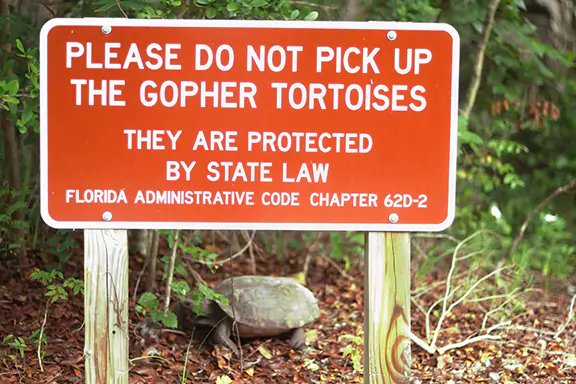The gopher tortoise (Gopherus polyphemus) is one of Florida’s most important and legally protected reptiles. As a keystone species, gopher tortoises support over 350 other animals that rely on their burrows for shelter and survival, including the gopher frog, snakes, and insects.
Because of their ecological value and declining numbers due to habitat loss, gopher tortoises are classified as a threatened wildlife species in Florida. This means strict regulations govern everything from land clearing to relocating tortoises. Failing to follow these laws—intentionally or accidentally—can result in serious legal and financial penalties for property owners, developers, and government agencies.
This article breaks down the key parts of Florida gopher tortoise laws, including what’s protected, what’s prohibited, and why it’s essential to get a survey and proper permits before disturbing any site where gopher tortoises may live.
Gopher Tortoises Are a Protected Species in Florida
Legal Status Under Florida Law
Gopher tortoises are protected under Chapter 68A-27 of the Florida Administrative Code (F.A.C.). According to the Florida Fish and Wildlife Conservation Commission (FWC), it is illegal to:
Take, capture, possess, sell, or transport a gopher tortoise
Disturb, collapse, damage, or fill in a gopher tortoise burrow
Harass or harm the tortoise, its eggs, or the burrow in any way
This includes activities as common as land development, grading, or running heavy equipment through areas with sandy soils, where tortoises commonly dig burrows.
Florida law protects both the tortoise and the burrow, even if the tortoise is not visible at the time of disturbance. In most cases, property owners must obtain a permit from the FWC before any activity can begin on land where tortoises are present.
What the Law Says About Gopher Tortoise Burrows
Burrows Are Legally Protected — Not Just the Animal
A gopher tortoise burrow is typically a long tunnel with a distinct shape matching the tortoise’s shell, often described as a “half-moon” at the entrance. These deep burrows, which can extend up to 40 feet, provide shelter not only for adult tortoises but also for a wide range of other species.
Because these burrows play such a critical role in supporting native wildlife, state law protects them from disturbance just as strongly as the tortoise itself. This includes:
Accidental destruction during construction
Damage during land clearing, fencing, or landscaping
Soil collapse caused by heavy machinery
Blocking or filling burrow entrances
Gopher tortoises are territorial, and their home range is usually small. If a burrow is destroyed, the tortoise may not survive long enough to build a new one—especially during drought, high temperatures, or mating season.
Property owners who plan to develop land or clear vegetation must first have a survey conducted by a qualified professional. If active burrows are found, they are required to go through the state’s permitting process before any disturbance occurs.
Explaining the Penalties of Florida Gopher Tortoise Law
Violating Tortoise Laws Can Lead to Criminal Charges
The penalties for disturbing or harming gopher tortoises or their burrows in Florida are serious—and they apply whether you knew the tortoise was present or not. The Florida Fish and Wildlife Conservation Commission (FWC) enforces these rules under Chapter 68A-27 of the Florida Administrative Code.
Here’s what the law says:
Permit Violations (e.g., land clearing without authorization):
Classified as a second-degree misdemeanor
Punishable by up to 60 days in jail and/or a $500 fine per incident
Severe Violations (e.g., intentionally taking or killing a gopher tortoise or destroying its eggs):
Classified as a third-degree felony
Punishable by up to 5 years in prison and/or a $5,000 fine per torotoise
Florida’s statutes allow stacking of charges, so fines are effectively assessed per incident per animal/burrow impacted rather than one flat penalty – this is why compliance is critical for every single tortoise on a property.
These charges can apply to:
Property owners
Developers
Contractors and subcontractors
Municipal crews and government agencies
In addition to legal penalties, violations can result in stop-work orders, project delays, and loss of permits—especially for large-scale land development or government-funded infrastructure projects.
Why You Should Take These Penalties Seriously
Unfortunately, many people assume they can move or remove a tortoise without checking the law. Others believe they’re in the clear if the burrow looks inactive. But Florida law protects all gopher tortoise burrows unless a professional inspection confirms abandonment—and even then, documentation is required.
Don’t assume. If your project disturbs a burrow without approval, you are likely in violation, even if it was unintentional.

Permitting Requirements for Gopher Tortoise Relocation
When Permits Are Required
Any time a gopher tortoise is present on land slated for development, a permit is required to capture, handle, or relocate the tortoise. This includes:
Private residential lots
Commercial developments
Government-owned properties
Agricultural and pasture lands, depending on activity type
Permits are issued by the FWC and must be obtained before any site disturbance begins.
Procedures in the Permitting Process
Tortoise Survey and Site Evaluation
A licensed gopher tortoise agent inspects the land for active burrows.Permit Application to FWC
Includes documentation of burrow locations, capture plans, and recipient site information.Mitigation Contribution
All permits require a mitigation fee that supports statewide gopher tortoise conservation.Relocation
Tortoises are moved to certified recipient sites approved by the FWC. These sites must meet habitat requirements and offer long-term protection.Compliance Monitoring
In some cases, follow-up inspections or reporting are required to ensure relocation success and habitat stability.
On-Site vs. Off-Site Relocation
Landowners with 10 or fewer burrows may qualify for on-site relocation, provided the land can continue to support the tortoises. Larger projects or sites with unsuitable habitats must relocate the tortoises to an approved off-site facility.
Only certified agents can perform the actual capture and relocation process. Doing this yourself—even with good intentions—can result in permit violations and penalties.
Why Professional Surveys and Relocation Are the Best Option
Protect Your Property and Stay Compliant
Whether you’re managing a small residential lot or preparing a large-scale commercial or government project, it’s always safer—and smarter—to have a professional inspect your site for gopher tortoise burrows before starting any work.
Certified gopher tortoise agents understand how to:
Accurately identify active burrows
Document site conditions and apply for the proper permits
Capture and relocate tortoises according to FWC-approved procedures
Ensure that your project moves forward without legal setbacks
Trying to cut corners or delay the process can result in serious legal consequences and expensive project delays. Even if you’re unsure whether a burrow is active, it’s better to request an inspection than risk violating Florida gopher tortoise laws.
The Benefits of Doing It Right
Avoid costly misdemeanor or felony charges
Prevent project delays from stop-work orders
Protect Florida’s native wildlife and comply with state law
Support long-term conservation efforts through proper mitigation
The gopher tortoise is a vital part of Florida’s natural heritage, and the law treats it that way. If you suspect tortoises may inhabit your property—or if you’ve already seen one—it’s time to act responsibly and legally.
Protect Wildlife, Avoid Penalties, and Keep Projects on Track
Florida’s gopher tortoise laws are clear: you cannot disturb a tortoise or its burrow without a permit. The consequences of ignoring these laws can include steep fines, criminal charges, and major project delays.
But with proper planning, site surveys, and legal relocation, you can meet all state requirements and continue your work without issues. Whether you manage residential, commercial, or governmental property, partnering with professionals is the most effective way to protect your investment—and Florida’s native wildlife.
Do you have a gopher tortoise—or suspect active burrows—on your land in Florida?
Contact Premier Gopher Tortoise Services today to schedule a licensed inspection, secure permits, or relocate tortoises safely and legally.

